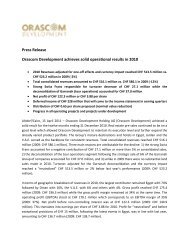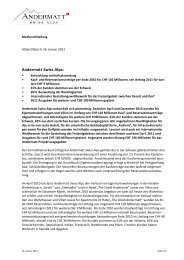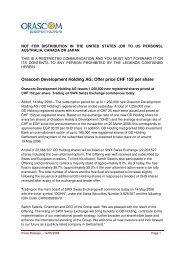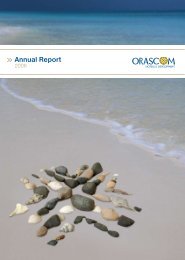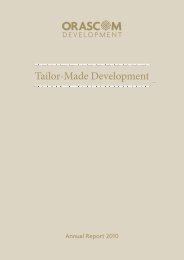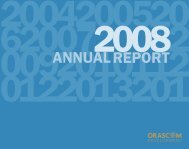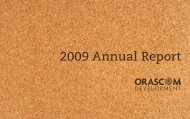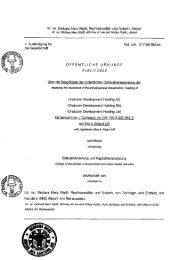FY 2012 Annual Report - Orascom Development
FY 2012 Annual Report - Orascom Development
FY 2012 Annual Report - Orascom Development
You also want an ePaper? Increase the reach of your titles
YUMPU automatically turns print PDFs into web optimized ePapers that Google loves.
F-69 <strong>Orascom</strong> <strong>Development</strong> <strong>2012</strong> <strong>Annual</strong> <strong>Report</strong> F-70<br />
The gearing ratio at the end of the reporting period was as follows:<br />
CHF <strong>2012</strong> 2011<br />
Debt (i) 603,860,850 536,210,821<br />
Cash and cash equivalents (101,668,196) (79,399,104)<br />
Net debt 502,192,654 456,811,717<br />
Equity (ii) 977,851,660 1,095,216,884<br />
Net debt to equity ratio 51.36% 41.71%<br />
(i) Debt is defined as long- and short-term borrowings (excluding derivatives), as detailed in (note 31).<br />
(ii) Equity includes all capital and reserves of the Group and non- controlling interests that are managed as capital.<br />
40.2 Significant accounting policies<br />
Details of the significant accounting policies and methods adopted, including the criteria for recognition, the basis of<br />
measurement and the basis on which income and expenses are recognised, in respect of each class of financial asset, financial<br />
liability and equity instrument are disclosed in 3.19 Financial instruments.<br />
40.3 Categories of financial instruments<br />
CHF <strong>2012</strong> 2011<br />
Financial assets<br />
Cash and bank balances 101,668,196 79,399,104<br />
Fair value through profit or loss ( FVTPL)<br />
Held for trading non-derivative financial assets 291,121 7,294,817<br />
Fair value through other comprehensive income (FVTOCI) 54,319,056 39,609,291<br />
Financial assets measured at amortized cost 246,852,041 337,305,329<br />
Financial liabilities<br />
Derivative instrument in designated hedge accounting relationship 562,337 1,264,931<br />
At amortised cost 1,008,615,520 784,305,564<br />
40.4 Financial risk management objectives<br />
In the course of its business, the Group is exposed to a number of financial risks. This note presents the Group’s objectives, policies<br />
and processes for managing its financial risk and capital.<br />
The Group’s Corporate Treasury function provides services to the business, co-ordinates access to domestic and international<br />
financial markets, monitors and manages the financial risks relating to the operations of the Group through internal risk reports<br />
which analyse exposures by degree and magnitude of risks. These risks include market risk (including currency risk, interest rate<br />
risk and other price risk), credit risk and liquidity risk. Other price risk includes equity price risk, settlement risk and commodity<br />
price risk.<br />
It is, and has been throughout <strong>2012</strong> and 2011, the Group’s policy not to use derivatives without an underlying operational<br />
transaction or for trading (i.e. speculative) purposes.<br />
The Group seeks to minimise the effects of these risks mainly through operational and finance activities and, on occasional basis,<br />
using derivative financial instruments to hedge these risk exposures. The use of financial derivatives is governed by the Group’s<br />
internal policies and procedures approved by the Board of Directors, which provide written principles on foreign exchange risk,<br />
interest rate risk, credit risk, the use of financial derivatives and non-derivative financial instruments, and the investment of excess<br />
liquidity. The Group does not enter into or trade financial instruments, including derivative financial instruments, for speculative<br />
purposes.<br />
The Corporate Treasury function reports monthly to the Executive Management. The Group Treasury Director carries out risk<br />
management under the Group’s guidelines.<br />
40.5 Market risk<br />
The Group’s activities expose it primarily to the financial risks of changes in foreign currency exchange rates (see 40.6 below) and<br />
interest rates (see 40.7 below).<br />
Driven by the need, the Group’s policy is to enter into a variety of derivative financial instruments to manage its exposure to<br />
foreign currency risk and interest rate risk, including:<br />
– forward foreign exchange contracts to hedge the exchange rate risk arising on sales in foreign currency to the tourism / real<br />
estate industry;<br />
– interest rate swaps to mitigate the risk of rising interest rates<br />
40.6 Foreign currency risk management<br />
The Group undertakes certain transactions denominated in foreign currencies. Hence, exposures to exchange rate fluctuations<br />
arise. The currencies, in which these transactions primarily are denominated, are US Dollar (USD), Euro (EUR) and Egyptian Pound<br />
(EGP). Exchange rate exposures are managed within approved policy parameters utilising forward foreign exchange contracts.<br />
The Group’s main foreign exchange risk arises from sales in foreign currency to the tourism / real estate industry, which generates<br />
a net foreign currency surplus for the Group. The Group has strong inflows in foreign currency, mainly US Dollar, Euro, Oman Rial<br />
and Egyptian Pound.<br />
Out of the total receivables on hand at the end of the reporting period, receivables in USD have accounted for 32% (2011: 40%), in<br />
EUR for 7% (2011: 6%),in EGP for 46% (2011: 41%) and in CHF for 13% (2011: 11%) respectively.<br />
To mitigate the above risk exposures, where possible, the Group borrows in matching currencies to create a natural hedge. The<br />
following table shows the carrying amounts of borrowings, at the end of the reporting period, in the major currencies in which<br />
they are issued.<br />
Borrowing<br />
CHF <strong>2012</strong> 2011<br />
USD 215,885,556 36% 243,970,612 46%<br />
EGP 212,183,963 35% 194,250,742 36%<br />
CHF 82,594,428 14% 9,307,207 2%<br />
EUR 68,706,387 11% 77,275,959 14%<br />
OMR 14,226,606 2% - -<br />
AED 5,540,243 1% 11,406,301 2%<br />
JOD 4,723,667 1% - -<br />
Total 603,860,850 100% 536,210,821 100%<br />
At the end of the reporting period, the carrying amounts of the Group’s major foreign currency denominated monetary assets<br />
(mainly receivables and finance lease receivables) and monetary liabilities (mainly borrowings), at which the Group is exposed to<br />
currency rate risk, are as follows:<br />
CHF Liabilities Assets<br />
<strong>2012</strong> 2011 <strong>2012</strong> 2011<br />
Currency-USD 215,885,569 243,970,615 60,683,312 105,229,240<br />
Currency-EUR 68,706,387 77,275,959 13,680,237 15,755,310<br />
Currency-EGP 212,183,963 194,250,742 86,127,603 109,624,884<br />
Residual foreign exchange exposure is managed by hedging through entering into foreign currency forward contracts.<br />
Currency risk has also recently developed due to the Group’s investments in different markets such as those in Egypt, UAE, Oman,<br />
Jordan, Morocco, Switzerland, Romania and the UK. Again, the Group borrows in the local currency of the investment and uses<br />
the above mentioned strategies to mitigate residual currency risk.<br />
40.6.1 Foreign currency sensitivity analysis<br />
As discussed above, the Group is mainly exposed to the US Dollar (USD), Euro (EUR) and Egyptian Pound (EGP) arising from sales<br />
in these currencies to the tourism / real estate industry.<br />
The following table details the Group’s sensitivity to a 5% increase and decrease in CHF against the relevant foreign currencies.<br />
The (5%) is the sensitivity rate used when reporting foreign currency risk internally to key management and represents<br />
management’s assessment of the reasonably possible change in foreign exchange rates. The sensitivity analysis includes only<br />
outstanding foreign currency denominated monetary items and adjusts their translation at the period end for a 5% change in<br />
foreign currency rates.<br />
F-69<br />
F-70



